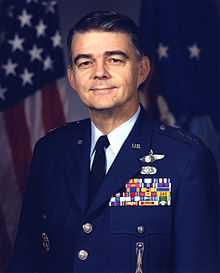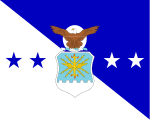Michael Dugan (general)
| Michael J. Dugan | |
|---|---|
 General Michael J. Dugan, USAF (Ret.) | |
| Born |
February 22, 1937 Aberdeen, South Dakota |
| Allegiance | United States of America |
| Service/branch | U.S. Air Force |
| Years of service | 1958–1990 |
| Rank | General |
General Michael J. Dugan (born February 22, 1937) was briefly the 13th Chief of Staff of the United States Air Force for 79 days in 1990 until he was dismissed by United States Secretary of Defense Dick Cheney after telling reporters that the U.S. military planned to target Saddam Hussein, his family, and even his mistress in the Gulf War with Iraq. He became the first member of the Joint Chiefs of Staff to be fired since Admiral Louis Denfeld in 1949, and the first top general to be relieved since General MacArthur in 1951.
Early life and education
Dugan was born in Albany, New York. He earned a Bachelor of Science degree from the United States Military Academy in 1958, and a master of business administration degree from the University of Colorado in 1972. He completed Squadron Officer School in 1965, Air Command and Staff College in 1970 and the Air War College in 1973.
Military career
His early operational assignments were in F-100s and A-1s. He flew A-1s during 1967, from Pleiku Air Base, Republic of Vietnam, and Nakhon Phanom Royal Thai Air Force Base, Thailand. He then planned and taught cadet military training courses and served as cadet squadron and group air officer commanding at the United States Air Force Academy.
From June 1973 to July 1977, Dugan was assigned to Headquarters U.S. Air Force, Washington, D.C., as an action officer and branch chief in the Office of the Deputy Chief of Staff, Plans and Operations, and then as executive to the vice chief of staff. He next served at Davis-Monthan Air Force Base, Arizona, as vice commander and, later, commander of the 355th Tactical Fighter Wing. He subsequently became commander of the 23rd Tactical Fighter Wing, England Air Force Base, Louisiana, and commander of the 832nd Air Division, Luke Air Force Base, Arizona.
In May 1982, he moved to Langley Air Force Base, Virginia, where he served successively as Tactical Air Command's assistant deputy chief of staff for operations, inspector general and deputy chief of staff for operations. He was assigned to the deputy chief of staff for plans and operations at Air Force headquarters as director of operations in June 1986, and as assistant deputy chief of staff in January 1987. He became the Air Force deputy chief of staff, programs and resources, in July 1987. He then became deputy chief of staff, plans and operations, in March 1988. He assumed his command of U.S. Air Forces in Europe in April 1989.
General Dugan is a command pilot with 4,500 flying hours and 300 combat missions. His military decorations include the Air Force Distinguished Service Medal, Silver Star, Legion of Merit with two oak leaf clusters, Distinguished Flying Cross, Purple Heart, Air Medal, Air Force Commendation Medal with two oak leaf clusters and Republic of Vietnam Gallantry Cross with Palm.
He was promoted to General on May 1, 1989, with the same date of rank, and became Air Force chief of staff in July 1990.
As chief, he served as the senior uniformed Air Force officer responsible for the organization, training and equipage of a combined active duty, Guard, Reserve and civilian force of nearly 1 million people serving at approximately 3,000 locations in the United States and overseas. As a member of the Joint Chiefs of Staff, he and the other service chiefs functioned as the principal military advisers to the Secretary of Defense, National Security Council and the President. During his brief tenure as Chief of Staff, Alaskan Air Command stood down, and was reduced to Numbered Air Force status as Headquarters, Eleventh Air Force, falling under the jurisdiction of Pacific Air Forces.
Removal from post
In September 1990, during the lead-up to the Gulf War after Saddam Hussein had invaded Kuwait, General Dugan revealed to reporters that the U.S. military had plans to bomb Baghdad relentlessly and "decapitate" the Iraqi leadership by targeting Hussein personally, along with his family, his senior commanders, his palace guard and even his mistress.[1] He said that he had personally "assigned a team to find Iraqi military defectors, knowledgeable professors, Iraqi expatriates and journalists who recently have visited Baghdad to learn more about Iraqi culture" so that he could get "a better list" of targets that would cause the most psychological damage to the Iraqi people if bombed. "The list stressed the importance of attacking Hussein and his inner circle, but beyond that, Dugan would not detail the potential Iraqi leverage points he intend[ed] to try to destroy."
United States Secretary of Defense Dick Cheney who had warned Dugan previously about speaking with journalists because he was known to be "loose-lipped"[2] fired General Dugan. Cheney said that Dugan showed "poor judgment at a sensitive time" [3] adding, "We never talk about the targeting of specific individuals who are officials of other governments. Taking such action might be a violation of the standing presidential executive order" banning assassinations.[4] Dugan was replaced by Merrill McPeak and retired from the Air Force on December 31, 1990. On January 17, 1991, the aerial bombardment of Iraq began which destroyed much of the civilian infrastructure of Iraq, though Saddam Hussein, his family, and mistress were unharmed.
Post-military career
General Michael Dugan went on to serve as the president of the National Multiple Sclerosis Society and is now President-Emeritus of that organization.
See also
- Dugan
- Seán Mór Ó Dubhagáin (d.1372) Gaelic-Irish poet.
- Patrick Duggan (10 November 1813-15 August 1896) Roman Catholic Bishop of Clonfert
See also
References
- ↑ Broder, John M. (September 16, 1990). "U.S. War Plan in Iraq: 'Decapitate' Leadership : Strategy: The Joint Chiefs believe the best way to oust the Iraqis would be air strikes designed to kill Hussein.". Los Angeles Times. Retrieved 9/2/2011. Check date values in:
|accessdate=(help) - ↑ Broder, John M. (September 18, 1990). "Cheney Aides Warned Dugan on Media : Military: Worried about his loose tongue, they had urged him not to take journalists on Saudi tour.". Los Angeles Times. Retrieved 9/2/2011. Check date values in:
|accessdate=(help) - ↑ Schmitt, Eric (September 18, 1990). "CONFRONTATION IN THE GULF; AIR FORCE CHIEF IS DISMISSED FOR REMARKS ON GULF PLAN; CHENEY CITES BAD JUDGMENT". The New York Times.
- ↑ Broder, John M. (September 18, 1990). "Air Force Chief Fired by Cheney : Military: Gen. Dugan used 'poor judgment' in discussing possible Iraq targets, the defense secretary says. The general talked of attacking Hussein and his family.". Los Angeles Times. Retrieved 9/2/11. Check date values in:
|accessdate=(help)
| Military offices | ||
|---|---|---|
| Preceded by Gen. Larry D. Welch |
Chief of Staff of the United States Air Force 1990 |
Succeeded by Gen. John M. Loh (acting) |
| ||||||||||
